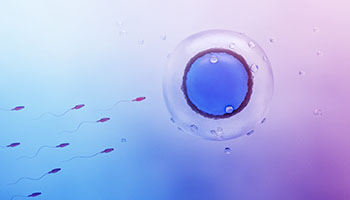HOW CAN WE HELP YOU? Call 1-800-TRY-CHOP
In This Section
What’s in a Sperm? Research Suggests, Stress, Diet, and Small RNAs

Fathers may pass along more than just genetics to their offspring.
limjr [at] chop.edu (By Jillian Rose Lim)
Fathers’ lifestyle factors could have a more far-reaching influence on their offspring than once thought. Alongside typical traits such as height, hair color, or having an allergic tendency, research is building to suggest that sperm, encoded with non-genetically inscribed notes modulated by diet or stress, can be transmitted during fertilization and contribute traits to the next generation.
This forms the foundation of research for Colin Conine, PhD, an assistant professor of Pediatrics and Genetics and investigator at Children’s Hospital of Philadelphia. As a selected scientist in the Pew Scholars Program in the Biomedical Sciences for 2021, Dr. Conine is elucidating the mechanisms behind this form of epigenetic inheritance in more detail than ever before. With four years of funding from Pew, his research utilizes advanced sequencing techniques to answer a number of questions: What kinds of cargo do sperm carry, and how does that cargo influence the metabolism or behaviors of the babies they produce?
“This idea that factors outside one’s DNA or genetics can influence traits or phenotype – let alone that of one’s offspring – has become increasingly appreciated,” Dr. Conine said. “And the fact that this happens specifically from the male side is particularly interesting. For years, it’s been thought that sperm only contribute the genome – it drops the genome off and that’s it. But this work – it’s background and our current research – makes people really re-consider how we think about fertilization and the role of sperm in early development.”
Environment Matters: Inheriting Lifestyle Traits
In the last 10 to 15 years, scientists have slowly built a case for the influence of environment or lifestyle factors on offspring, with two well-documented examples of this for fathers: diet and stress.
In both human and animal models, a poor diet has been shown to affect the metabolic phenotypes of progeny. As a postdoc, Dr. Conine found that male mice who were fed a low-protein diet exhibited altered levels of RNA in their sperm and that further, their offspring expressed a different metabolic profile than those who – though genetically the same – were born to males fed a normal diet. One of the strongest human examples of this phenomenon is the epidemiological Dutch Hunger Winter study. During the Dutch famine of 1944 to 1945, a German blockade impeded food supply to cities in the Netherlands. Many years later, scientists found that children in utero while their parents endured the famine exhibited a unique metabolic phenotype: In middle age, they experienced higher rates of obesity and diabetes and showed higher levels of triglycerides and LGL cholesterol.
Scientists have made similar discoveries when it comes to stress. In human and animal studies, evidence suggests that when a father is stressed, their offspring exhibit phenotypes related to changes in behavior or a susceptibility to stress.
“What scientists have found is that what’s actually encoding this information in sperm are changes in small regulatory RNAs,” Dr. Conine said.
Building a Comprehensive Picture of Regulatory RNAs
RNAs are best known as messengers molecules, helping to carry instructions for DNA that result in the synthesis of proteins. Scientists now know, however, that RNAs also can play a regulatory role. Aptly called regulatory RNAs, they have the ability to turn genes on or off (an epigenetic change), thus contributing bits of information to the cell.
“RNA's can regulate gene expression themselves, and we’ve identified a few different types of small regulatory RNAs that can actually do this intergenerationally,” Dr. Conine said.
For paternal diet, scientists have identified small regulatory RNAs called tRNA fragments. Dr. Conine’s study on low-protein diets links protein restriction to changes in sRNA levels – in particular, increased amounts of tRNA fragments. Paternal stress, meanwhile, influences another type of regulatory RNA called microRNAs. These findings are just the start.
“Only a few of these different RNA's have really been looked at and shown to actually transmit a phenotype from sperm to the progeny,” Dr. Conine said. “But there are hundreds, or even thousands, of different RNA's in sperm. And so, one of the things that we're proposing to do specifically in the Pew-funded research, is to characterize all of them.” To do this the lab has developed novel sequencing techniques to comprehensively all types of RNA in sperm.
After creating a comprehensive overview of all RNAs in sperm, the next step is to test which RNAs contribute information for the next generation. To do this, Dr. Conine and his team will study sperm from several different mammal species to identify regulatory RNAs with a conserved presence in sperm. They will then dissect their functions by going back to mouse eggs and microinjecting candidates RNAs, determining how the RNAs regulate embryonic gene expression and affect offspring phenotypes.
“We can look at small regulatory RNAs, some of which have been identified as epigenetic carriers from sperm to progeny,” Dr. Conine said. “But we’re also going to look at bigger RNAs like mRNAs and other less studied RNAs that haven't really been looked at or appreciated in sperm.”